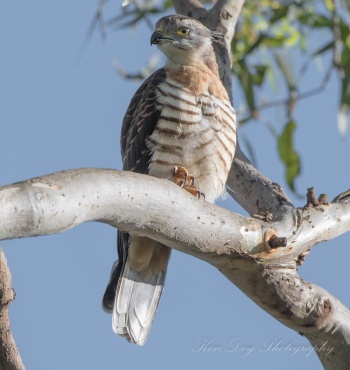Alternative names: Crested Hawk, Baza, Pacific Cuckoo-Falcon
- Aviceda subcristata
Identification
35–46 cm; long tail and prominent crest
- Grey head, neck and breast
- White underparts with bold dark banding
- Short legs
- Yellow eyes
The female is heavier and browner on the crown than the male.
Distribution
Northern and eastern Australia, Indo-Malayan peninsula, New Guinea and nearby islands and the Solomon Islands.
Taxonomy
Subspecies
There are 13 subspecies[1]:
- A. s. timorlaoensis: Lesser Sundas and islands off Sulawesi
- A. s. pallida: Seram Laut (Manawoka and Gorong) and Kai Islands
- A. s. reinwardtii: South Moluccas (Boano, Seram, Ambon and Haruku)
- A. s. stresemanni: Buru (central Moluccas)
- A. s. rufa: Moluccas (Morotai, Halmahera, Ternate, Tidore, Bacan and Obi)
- A. s. waigeuensis: Waigeo Island (off northern New Guinea)
- A. s. obscura: Biak Island (off northern New Guinea)
- A. s. stenozona: Aru Islands and western New Guinea
- A. s. megala: Eastern New Guinea
- A. s. coultasi: Admiralty Islands
- A. s. bismarckii: Bismarck Archipelago
- A. s. gurneyi: Solomon Islands
- A. s. subcristata: Northern and eastern Australia
Habitat
Rain and swamp forests and forest edges, mangroves, grasslands, farmlands and urban areas. They prefer well-watered areas.
Behaviour
Diet
Omnivorous. Their mains diet includes large insects, particularly stick insects and mantids, frogs, lizards and fruit.
Breeding
The nest is flimsy and flat and made of sticks; it is placed high in the upper leafy branches of a tree. The clutch consists of 2-4 eggs. Both adults brood and feed the chicks.
Vocalisation
Loud, high pitched "eee-chew." Noisy during breeding season.
Movements
Mostly sedentary. Extreme southern SE populations in Australia are partly migratory.
References
- Clements, J. F., T. S. Schulenberg, M. J. Iliff, S. M. Billerman, T. A. Fredericks, B. L. Sullivan, and C. L. Wood. 2019. The eBird/Clements Checklist of Birds of the World: v2019. Downloaded from http://www.birds.cornell.edu/clementschecklist/download/
- Debus, S. & Kirwan, G.M. (2019). Pacific Baza (Aviceda subcristata). In: del Hoyo, J., Elliott, A., Sargatal, J., Christie, D.A. & de Juana, E. (eds.). Handbook of the Birds of the World Alive. Lynx Edicions, Barcelona. (retrieved from https://www.hbw.com/node/52951 on 6 November 2019).
- Birds in Backyards
- Global Raptor Information Network. 2019. Species account: Pacific Baza Aviceda subcristata. Downloaded from http://www.globalraptors.org on 6 Nov. 2019
- Gregory, P. (2017) Birds of New Guinea, Including Bismarck Archipelago and Boughainville. Lynx Edicions, Barcelona.
Recommended Citation
- BirdForum Opus contributors. (2024) Pacific Baza. In: BirdForum, the forum for wild birds and birding. Retrieved 8 November 2024 from https://www.birdforum.net/opus/Pacific_Baza
External Links
GSearch checked for 2020 platform.1






